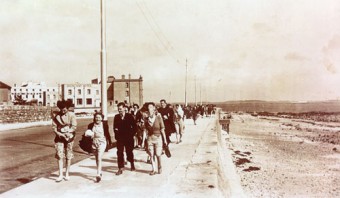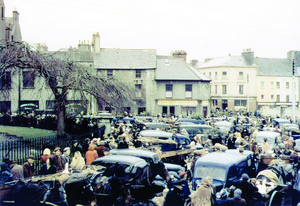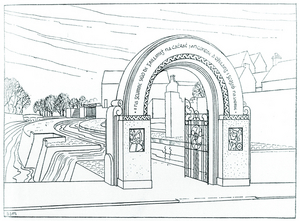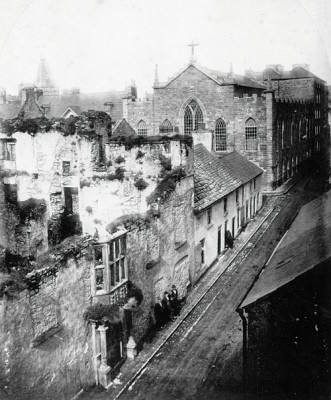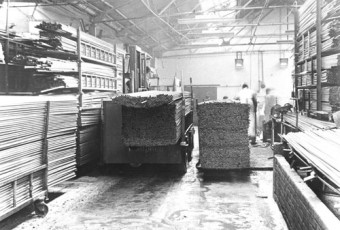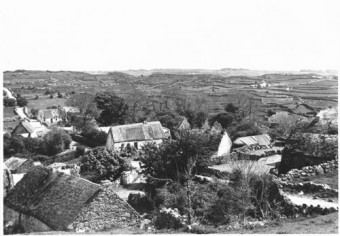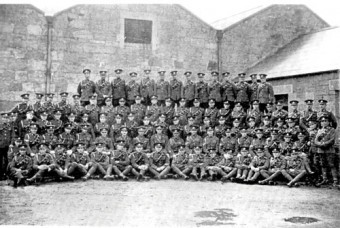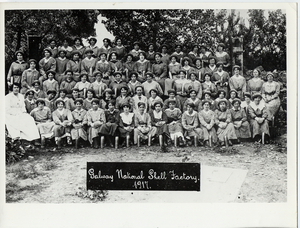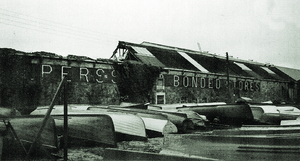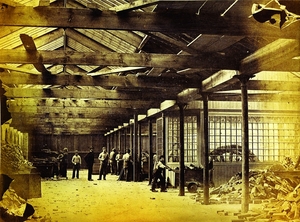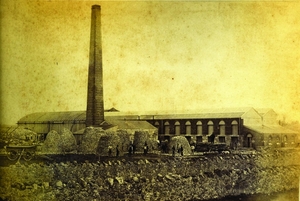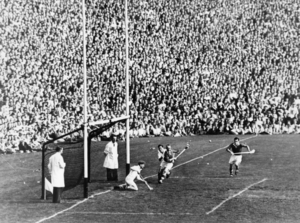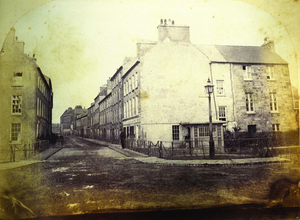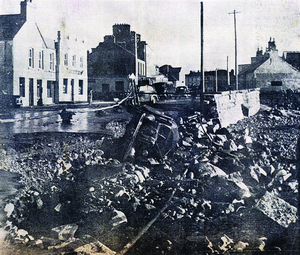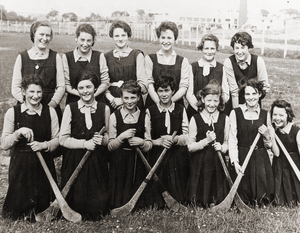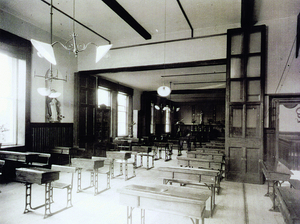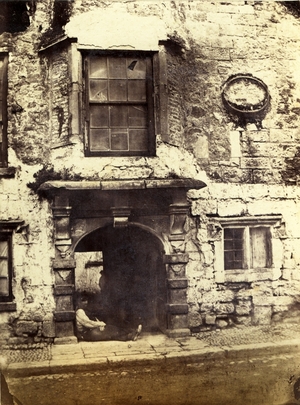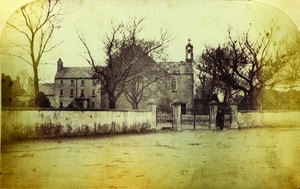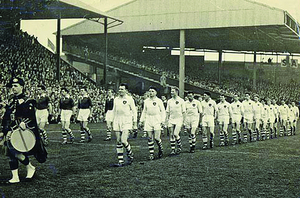Salthill Prom in the fifties
Thu, Jan 09, 2014
The Prom has been much in the news in the last few days. In Victorian times, our ancestors used to advertise the Promenade as a place unrivalled in the country, where a person could take the healthy invigorating air like nowhere else. In those days, it was just a narrow crooked roadway, very rough and untarred, and it extended from Palmer’s Rock to Blackrock. There were no shelters or flower beds, indeed there was hardly any beach, just rocks and shingle and seaweed. The cleaning up process started when breakwaters and piers were built, so there is a lot more beach now than there was 60 years ago. There were no large boulders to strengthen the Promenade, and flooding from the tide was far more regular than it is today – with the experience of this past couple of weeks excepted.
Read more ...Galway market in the mid-twentieth century
Thu, Jan 02, 2014
“Let not the visitor miss the joyful chaos of Galway’s week-end purchasing. Saturday is not a day of speed. Petrol must give way to horsepower and donkey-power, and cattle that like to investigate both sides of a road. Proud, glittering models of fame crawl humiliatingly in face of a stream of vehicles of astonishing build and variety, rumbling in from Connemara. Carts piled with sacks of oats, potatoes, flour; others with crates of wondering calves and bewildered fowls. It is the great day – not necessarily a happy one – of small brown donkeys further dwarfed by huge wheels and the garden produce heaped above them. Around you in the streets, or about the food market in the shadow of the ancient church, you can hear the musical Gaelic speech. Tall, handsome women of Spanish type dark-haired and dignified: island women whose features speak hardiness and force of character: and women of the rock-strewn dazzling region about Carraroe unwittingly bring upon themselves the staring that notabilities endure. The men also receive attention. Of fine physique their faces healthily browned by sea and mountain winds, they attract you so that you wander, fascinated, from group to group. Old men in home spun, with the wide-brimmed Connemara hats, and the younger in tailored suits and coloured felts of fashion are alike in keenness of selling and shrewdness of buying.”
Read more ...The Galway volunteer memorial committee
Fri, Dec 27, 2013
This committee, also known as Coiste Cuimhneacháin Óglach Condae na Gaillimhe, was set up in the late 1940s, and represented all shades of political opinion. Its objective was to erect a memorial gateway to the memory of all the men and women of Galway city and county who suffered for freedom during the years 1916 to 1923. The chairman of the committee was Louis O’Dea and the joint honorary secretaries were Mrs T Dillon and Mr John Hosty.
Read more ...Christmas Day in the Pro-Cathedral, 1842
Thu, Dec 12, 2013
This photograph of Lower Abbeygate Street was taken from the top of a warehouse on the corner of Whitehall c1870. In the foreground you can see the remains of the Browne Mansion, and the original site of the Browne Doorway. Further up the street is the Pro-Cathedral, which was the site of an appalling disaster on Christmas Day, 1842. The following, which appeared in The Dublin Pilot, is a graphic account of what happened.
Read more ...The Conradh na Gaeilge Oireachtas and Ard-Fheis held in the Town Hall 1913
Thu, Dec 05, 2013
Conradh na Gaeilge, also known as the Gaelic League, was founded by Douglas Hyde and Eoin McNeill in July 1893. Their aim was to keep the Irish language alive and preserve the Gaelic elements of Ireland’s culture. It was open to all creeds, was non-political, and accepted women on an equal basis. It used a broad approach, organising classes and competitions in Irish music, dancing, literature, and games. After a sluggish six years in existence, it suddenly morphed into a mass movement.
Read more ...Irish metal industries
Thu, Nov 28, 2013
Over the last few weeks we have been writing about the building on Earl’s Island which began life as a bleach and flax mill in the 1850s. It was then converted into a jute factory, became a bonded warehouse, a factory for making cannon shells during World War I, and was occupied by the 6th Dragoon Guards and the 17th Lancers during the War of Independence. After the British army left, it was vacant for a while before being converted into a factory known as IMI, or Irish Metal Industries.
Read more ...Shantalla village, 1945
Thu, Nov 21, 2013
This remarkable photograph of Shantalla village was taken in 1945 by Pádraic Mac Dubháin and is from the National Museum collection. You will sometimes see the place name written as Shantallow and you will hear it pronounced Shantla by people with Galway accents. It is derived from the Irish ‘Sean Talamh’, old ground, though why Shantalla should be older ground than that which surrounds it is a mystery. Maybe it is because some of the land was not being worked.
Read more ...The 17th Lancers in Earl’s Island
Thu, Nov 14, 2013
When World War I finished and the National Shell Factory on Earl’s Island closed down, the buildings were taken over by the 6th Dragoon Guards who had a reputation for wanton brutality. This was unusual in that most well armed British army units, with few having a role in the intelligence conflict, were rarely attacked during the War of Independence in the west of Ireland. While individual RIC men became defined as ‘good’ or ‘bad’, it was army regiments, rather than individual soldiers, that became so defined.
Read more ...The Galway national shell factory
Thu, Nov 07, 2013
During the First World War, towns and cities throughout Britain and Ireland had factories producing munitions for the battlefield. Galway was not one of these locations and indeed many Galwegians were travelling to the UK to work in these factories. There was a lot of criticism over this and so the members of the Urban Council and some local industrialists began a lobbying campaign to attract such an industry to the city. It would create employment and would be beneficial to the community.
Read more ...Persse’s Bonded Warehouse, Earl’s Island
Thu, Oct 31, 2013
Two weeks ago in this column, we showed some photographs of the Jute Spinning factory in Earl’s Island, and what I thought were large stacks of turf beside the building. An eagle eyed reader has pointed out that these were not sods of turf, they were ‘jute butts’, stems of the jute plant from which the fibres were extracted. They were stacked out in the fresh air because they are easier to work when wet. The fibres that made up the rough jute products were extracted from the top half of the plant.
Read more ...The Galway Jute Spinning Company
Thu, Oct 24, 2013
There seems to have been a few different names on this business but it was known locally as the bag factory. The chairman, Lieutenant Colonel James O’Hara, reported to the Select Committee on Industries Ireland (1884-85) on the company.
Read more ...The Galway jute factory
Thu, Oct 17, 2013
The Galway Vindicator and Connaught Advertiser of December 24 1851 carried an advertisement which read “TO BE LET, for such terms as may be agreed upon, and immediate possession given. EARL’S ISLAND MILL AND BLEACH GREEN. These well-known concerns occupied for so many years by the late Mr Mitchell, Linen Manufacturer, Miller, Bleacher, have always been esteemed to point of situation; preferable to every other site in Galway, but the improvement made by the Board of Works under the inspection of their skilful engineer SU Roberts ... have rendered it superior to any in the Kingdom. The land will be secured against being flooded for any part of the year. The Mill Race has been changed ... the Mill Power amended and is now equal to 40 horse power. The canal between Lough Corrib and the sea leaves the lake at the very point on which the Mill stands. The layby for boats is within 20 yards of it, and the spacious quay with landing crane and every accommodation for shipping goods will adjoin.”
Read more ...‘Up goes that hand again for Galway’
Thu, Oct 03, 2013
Those words were a regular part of Mícheál Ó Hehir’s radio commentary on hurling matches in the 1940s and 1950s when Galway were playing. The hand he was talking about belonged to Sean Duggan, who was arguably the greatest goalkeeper ever in the history of the game.
Read more ...Lower Dominick Street about one hundred and fifty years ago
Thu, Sep 26, 2013
According to Hely Dutton, Dominick Street was built in the early part of the 19th century. It was outside the old city walls and was an indicator of how Galway was beginning to expand at the time. This photograph, which was taken c1965, is probably the earliest existing image of the street.
Read more ...Hurricane Debbie
Thu, Sep 19, 2013
On the morning of September 16 1961, gale warnings were issued because of a possible impending storm. Violent storms are almost never actual hurricanes by the time they reach Ireland, but all of that was about to change that morning. Hurricane Debbie was the only hurricane, that is known about, to have made landfall in Ireland as a Category 1 event. Gusts of more than 180 kilometres an hour were recorded, and while the winds were not as strong as the gusts, they were capable of causing a lot of damage. Eighteen people died in Ireland as a result of the storm, six in the North and 12 in the South. They were killed by collapsing walls and trees, one was drowned from a small boat, and a young boy was blown into a stream. Tens of thousands of houses and other structures were damaged, some were completely destroyed, some suffered roof loss, while others had lesser damage such as windows blown in, etc.
Read more ...Galway camogie
Thu, Sep 12, 2013
We know from the old sliotars on exhibition in the folk museum in Turlough near Castlebar that the game of hurling has been played for many centuries, but what of the game of camogie? Two prominent Irish language enthusiasts and cultural nationalists, Máire Ní Chinnéide and Cáit Ni Dhonchadha, were credited with having created the sport while a brother of Cáit, Tadg, was the person who drew up the rules in 1903. So there was always a male presence within the administrative ranks of the sport. The game emanated from the Gaelic League and was dependent on the structures and networks provided by that organisation during the initial expansion of the sport. It was also closely linked with the GAA.
Read more ...The Dominican school at Taylor’s Hill
Thu, Sep 05, 2013
As the Penal Laws began to relax at the beginning of the 19th century and conditions became a little more lenient for Catholic religious orders, some of them began to think of a return to community life. The Dominican Nuns, whose community had flourished during Penal times, was now reduced to six. There was a lot of building going on in the area of their nunnery in Cross Street, and houses closed in their convent on all sides, making a life of strict enclosure very difficult. The sisters began to search for another house, more secluded, where they could follow their Rule, free from distraction.
Read more ...De Burgo’s mansion
Thu, Aug 29, 2013
This wonderful photograph, dated c1865, shows a carved stone doorway in Market Street, an interesting example of Renaissance work, almost certainly earlier than the Browne Doorway.
Read more ...The West Chapel
Thu, Aug 22, 2013
One hundred and ninety eight years ago this month (August 4, 1815), the first High Mass was sung in the West Chapel, and about 50 years later this photograph was taken of the exterior of the building. It was the third church the Dominicans had in the Claddagh.
Read more ...The 1956 All-Ireland final
Thu, Aug 15, 2013
Galway made it to the All-Ireland final in 1956 for the first time since 1942. They beat Mayo, Roscommon, Sligo, and Tyrone on the way and faced Cork in the final. The match was delayed for three weeks because of an outbreak of polio in Cork. It was played on October 7 in front of more than 70,000 people and it turned out to be one of the most exciting and thrilling finals in the history of the sport.
Read more ...